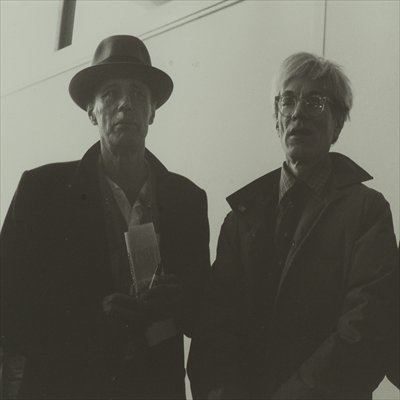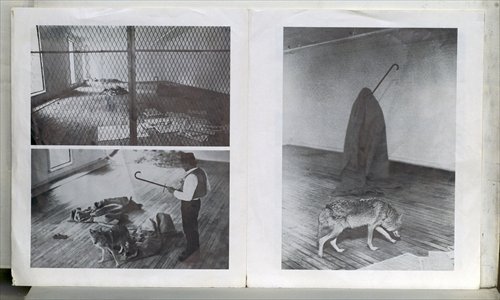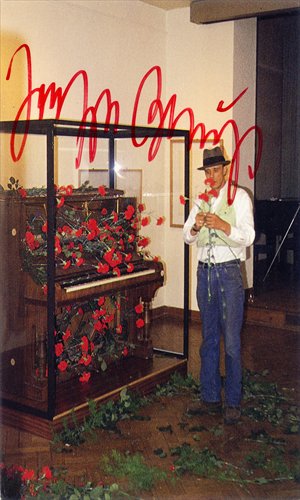Beuys meets Warhol

Beuys (left) photographed with Warhol in 1980.

Beuys' Coyote from Saltoarte

Beuys' Piano of Revolution Photos: Courtesy of Art Museum of CAFA
Zhu Qingsheng, a Peking University professor, summed up the German artist Joseph Beuys for World Art magazine in 1996 like so: "Comments about Beuys, in the art field and outside the art field are widely divided. However, few would doubt that he was the greatest artist in the 20th century whether you like his artwork or not."
Though Beuys is a prominent figure for many Chinese artists, there has never been a large-scale exhibition of his work in China - until now.
Starting this weekend, the Art Museum of China Central Academy of Fine Arts (CAFA) will hold the first Beuys show in Beijing, which will run until November 15.
At the end of September, the same art museum will also welcome an Andy Warhol exhibition. Thus, these two great artists will have a chance to "meet" each other almost 30 years after their deaths, in 21st century Beijing.
The man and the myth
Like Zhu's description, many assessments made about Beuys sound dramatic and sometimes unbelievable, but his image as a passionate and rational thinker remains, no hyperbole required.
So the story goes, Beuys was once a member of a combat bomber unit in the Luftwaffe, a branch of the German armed forces in World War II, and when his plane was shot down in 1944, he was rescued by nomadic Tatar tribesmen.
Beuys' work often employs animal pelts, said to be inspired by this rescue. The myth created mystery around him as well as different ways of interpreting his art.
Beuys' most well-known works include a land art piece in which 7,000 oak trees were planted in Kassel, Germany, and the performance piece How to Explain Pictures to a Dead Hare - both of which brought the artist attention and controversy.
Andy Warhol: 15 Minutes Eternal, a more familiar name for the Chinese public, will come to Beijing two weeks later, after the show's run in Shanghai from April to July. To better present a potential "dialogue" between the two great artists Beuys and Warhol, the Warhol exhibition here will vary slightly from its Shanghai presentation.
A curator's long quest
Curator of the Art Museum of CAFA Wang Huangsheng told the Global Times that he had the idea of bringing a Beuys exhibition to China back in 2006 when he was the curator at the Guangdong Museum of Art.
However, the process turned out to be more financially burdensome and time-consuming than expected. As a result, it wasn't until 2011, when Wang met an important collector in Germany, that he finally turned the idea into a reality, though still with two years of preparation.
Wang finds that Beuys has come back into popularity in recent years. The discussion about him has also risen to another level, involving more historical research of the former art giant, who died in 1986.
Titled Social Sculpture - Beuys in China, the exhibition organized by Chinese scholars, How Art Museum in Shanghai, K11 Art Foundation and Peking University's Center for Visual Studies will include more than 300 works.
Beuys stood against a special historical background when Germany needed to face a number of problems and feelings after the war. Beuys held a unique stance toward society and reacted to the reconstruction of German society at the time.
Although Beuys' attitude and personality were almost as strong as his artwork, his art can still shock at first sight, as Wang said it did for him when he viewed some Beuys pieces at the Pompidou Centre in Paris.
"For me, the most unforgettable work in the whole center was from Beuys," Wang said. "In a space that looks like a basement, animal pelts were laid one by one. It was so powerful and silent, seemed like all the sound would disappear there."
Significance today
For Chinese artists, direct and indirect influences from both Beuys and Warhol are obvious. The use of iron, stone and welding would all remind the audience of Beuys.
Similarly, Chinese political pop art, commonly seen in works by artists like Wang Guangyi, reflects Warhol's influence on Chinese artists.
For Wang, a more up-to-date source of inspiration should transcend art. The critical but rational engagement of Beuys in the social movements of the 1960s is applicable to the same time period in China. This serious attitude of criticism was strong enough for today's artist to continue to observe and learn from it.
Wang Chunchen, one of the exhibition's directors, told the Global Times that when the two artists intersect in Beijing, representing very different sides of art, it questions how we perceive art and define an artist.
"The best part was not about the representation or techniques but how they engaged society as artists," said Wang.
Beuys himself, as a performance artist and outspoken participant in history, is part of the art. He is critical, serious and his work must be considered in its historical and political context.
Problems produced by history will never disappear and in China, history, social issues and the rapid transformations happening nationally are all creating inspiration and new puzzles for artists.
In comparison, Warhol is more like an observer. He tells stories about consumerism and cultural topics in an economically booming era. Pop is his language but he speaks with more than just the colorful images. Topics referenced in Warhol's art are closely related to China's situation today.
Therefore this September should be a wonderful season for artists and thinkers to compare, relate and later create.